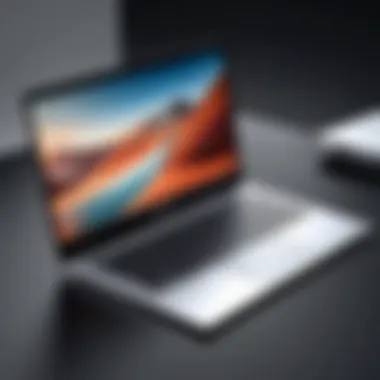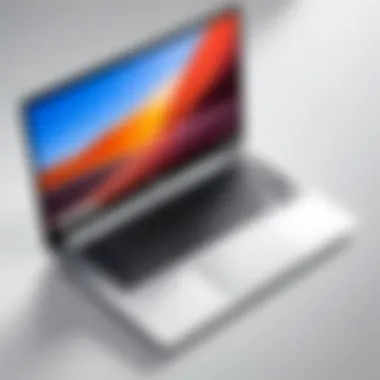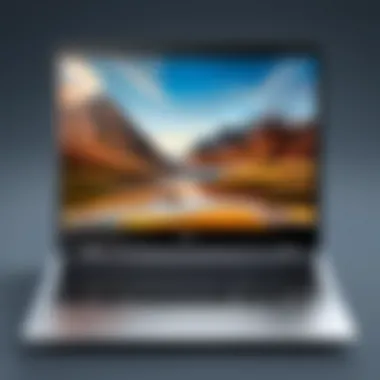Unveiling the Distinctions Between Laptops and Chromebooks: A Detailed Analysis


Product Overview
Laptops 🖥️ and Chromebooks 💻 stand as two distinct breeds in the realm of computing devices, each tailored to serve diverse user needs and preferences. Laptops, with their conventional design and extensive capabilities, have long been favored by those seeking robust performance and flexibility. On the other hand, Chromebooks offer a streamlined and simplified computing experience mainly centered around web-based activities. Understanding the subtle disparities between these devices is crucial for users aiming to make an informed decision tailored to their requirements.
Performance and User Experience
In scrutinizing the performance and user experience aspects, it becomes evident that laptops exhibit a wider diversity in hardware configurations and capabilities compared to Chromebooks. Laptops commonly feature higher processing power, advanced graphics capabilities, and ample storage options, enabling users to engage in resource-intensive tasks with efficiency. Meanwhile, Chromebooks prioritize seamless web browsing and lightweight tasks, capitalizing on their integration with the cloud for storage and software needs. During hands-on testing, users may find laptops to excel in multitasking, gaming, and content creation, whereas Chromebooks shine in web-based applications, portability, and battery life.
Design and Build Quality
Exploring the design and build quality of laptops versus Chromebooks unveils intriguing disparities in their construction. Laptops often boast sturdy constructions, premium materials, and versatile form factors, catering to varying user preferences ranging from ultraportable ultrabooks to robust gaming laptops. In contrast, Chromebooks tend to feature lightweight designs, budget-friendly materials, and modest aesthetics, emphasizing portability and affordability. The ergonomic considerations and durability aspects between laptops and Chromebooks reflect their targeted audiences, with laptops appealing to users valuing robustness and style, while Chromebooks attract those prioritizing portability and simplicity.
Technology and Innovation
Delving into the technological landscape of laptops and Chromebooks reveals distinctive approaches towards innovation and features. Laptops continually push boundaries with cutting-edge hardware advancements such as high-refresh-rate displays, powerful processors, and dedicated graphics cards, catering to the demands of professionals and enthusiasts alike. Chromebooks, on the other hand, emphasize simplicity and cloud integration, defying traditional norms of local storage to offer a lightweight and efficient computing experience. The potential impact of these devices on the consumer tech industry lies in their ability to cater to diverse user segments while hinting at future trends leaning towards cloud-centric computing and streamlined user interfaces.
Pricing and Value Proposition
A critical consideration for consumers contemplating between laptops and Chromebooks lies in their pricing and perceived value proposition. Laptops often come with a broader price spectrum, ranging from budget-friendly options to premium configurations, accommodating varying budgets and performance requirements. In comparison, Chromebooks generally offer cost-effective solutions suited for users prioritizing web-centric activities and affordability. While laptops present a wider array of features and customization options, Chromebooks appeal to users seeking a straightforward and budget-friendly computing solution. Evaluating the pricing details, value proposition, and competitive landscape can guide users towards selecting the device that aligns best with their usage patterns and budget constraints.
Introduction
In the realm of portable computing devices, the juxtaposition of laptops and Chromebooks sparks a compelling discourse on technological sophistication and user preferences. As we embark on this exploratory journey, the fundamental dissimilarities between these two gadgets come to light, unraveling a tapestry of features, functionalities, and adaptabilities that cater to a diverse spectrum of user needs. Understanding the core disparities between laptops and Chromebooks is pivotal in guiding consumers towards an educated decision-making process.
Defining Laptops and Chromebooks
Basic Overview of Laptops
Laptops, the stalwart companions of modern productivity, epitomize versatility and convenience in a compact form factor. With robust processing power and ample storage capacity, laptops serve as the quintessential workstation for professionals and enthusiasts alike. The key allure of laptops lies in their ability to seamlessly integrate productivity tools, multimedia capabilities, and communication utilities into a singular device, amplifying operational efficiency and content creation prowess. However, the portability of laptops often comes at a trade-off with battery longevity and streamlined design aesthetics, factors that consumers carefully weigh in their decision-making process.
Characteristics of Chromebooks
On the contrary, Chromebooks emerge as the epitome of streamlined functionality and cloud-centric computing. Characterized by their lightweight build and efficient reliance on Google's Chrome OS, Chromebooks offer users a nimble and hassle-free computing experience. The standalone feature of Chromebooks lies in their seamless integration with Google's suite of applications and web-based activities, fostering a user-friendly ecosystem for casual users and students. Nonetheless, the reliance on cloud storage and internet connectivity imparts limitations on offline functionality, posing a consideration for users with stringent offline workflow requirements.
Purpose of the Comparison


Helping Consumers Make Informed Decisions
The primary objective of this comparative analysis is to empower consumers with the knowledge needed to make well-informed decisions based on their unique requirements. By delineating the intrinsic disparities between laptops and Chromebooks, individuals can discern which device aligns harmoniously with their professional obligations, creative pursuits, or academic endeavors. Providing nuanced insights into the operational dynamics and user-oriented features of both devices equips consumers with the acumen necessary to navigate the expansive expanse of portable computing solutions.
Highlighting Key Factors for Consideration
In illuminating the key considerations for prospective buyers, this comparison not only elucidates the defining traits of laptops and Chromebooks but also accentuates the pivotal factors influencing purchase decisions. Ranging from performance metrics and software compatibility to design aesthetics and budgetary constraints, the discourse encapsulates a holistic vista of considerations that stakeholders should deliberate upon prior to making an investment. By accentuating the subtleties of each device's value proposition, users can sift through the myriad choices available in the market and converge upon a selection that resonates harmoniously with their individual predilections.
Technical Specifications
Operating Systems
Windows or mac
OS for Laptops
When assessing the operating systems of laptops, the choice often boils down to Windows or mac OS. Windows, known for its widespread usage across different brands and models, offers a versatile platform for various applications and software. On the contrary, macOS is esteemed for its seamless integration with Apple hardware, providing a cohesive ecosystem for users immersed in the Apple environment. Windows appeals to a broader audience due to its compatibility with a multitude of software, while macOS excels in user experience and design aesthetics.
Chrome OS for Chromebooks
Chrome OS, the operating system powering Chromebooks, embodies simplicity and efficiency. Designed by Google, Chrome OS focuses on web-based applications and cloud computing, making Chromebooks lightweight and fast. The streamlined interface of Chrome OS enhances user experience by prioritizing speed and security. However, Chrome OS may have limitations in running certain offline software or high-end applications, restricting its functionality compared to traditional operating systems like Windows and mac OS.
Hardware Components
Processor
The processor is the powerhouse of any computing device, impacting its speed and performance. In laptops, processors vary from basic models suitable for everyday tasks to high-end processors that enable heavy multitasking and gaming. Meanwhile, Chromebooks opt for energy-efficient processors optimized for web browsing and online tasks, emphasizing battery longevity over sheer processing power.
Storage
Storage space is a significant consideration when choosing between a laptop and a Chromebook. Laptops often provide larger storage capacities via hard drives or solid-state drives, accommodating extensive files and software. In contrast, Chromebooks rely heavily on cloud storage, offering limited onboard storage but promoting seamless access to files stored online.
RAM
RAM (Random Access Memory) plays a vital role in multitasking and overall system responsiveness. Laptops offer varying RAM capacities to suit different user needs, allowing for smooth operation of multiple applications simultaneously. Chromebooks, with their focus on web applications, typically come with sufficient RAM for efficient browsing and light productivity tasks.
Display


The display quality of a device significantly impacts user experience, influencing clarity, color accuracy, and viewing angles. Laptops often feature diverse display options, including high-resolution screens with vibrant colors ideal for multimedia consumption and graphic design. Chromebooks prioritize energy-efficient displays that maintain clarity while conserving battery life, making them ideal for prolonged web browsing and everyday productivity tasks.
Design and Portability
Design and portability play a crucial role in the user experience of laptops and Chromebooks. When considering these devices, it is essential to evaluate elements such as form factor and build materials to determine the most suitable option. The design not only affects the aesthetics but also impacts the practicality and convenience of the device in different usage scenarios.
Form Factor
Thin and Lightweight Laptops
Thin and lightweight laptops are designed to offer enhanced portability without compromising on performance. These laptops are popular among professionals and students who are always on the move and require a device that is easy to carry. The key characteristic of thin and lightweight laptops is their slim profile and reduced weight, making them ideal for travel and outdoor use. However, some users may find that the slim design limits certain hardware features and connectivity options compared to traditional laptops.
Compact and Sleek Chromebooks
Compact and sleek Chromebooks are known for their minimalist and streamlined design, focusing on simplicity and efficiency. These devices are preferred by individuals looking for a lightweight and unobtrusive computing solution. The key characteristic of Chromebooks is their compact size and sleek appearance, which are advantageous for users needing basic computing functions in a portable form factor. Despite their sleek design, Chromebooks may have limitations in terms of processing power and software compatibility compared to traditional laptops.
Build Materials
Metal vs. Plastic Construction
The choice between metal and plastic construction for laptops and Chromebooks significantly impacts durability and aesthetics. Metal construction provides a premium look and improved structural integrity, offering better protection against daily wear and tear. On the other hand, plastic construction helps in reducing the overall weight of the device and may offer cost benefits. The unique feature of metal construction is its ability to dissipate heat effectively, ensuring optimal performance during prolonged usage. However, plastic construction is more budget-friendly and may be preferred by users looking for lightweight and affordable devices. Both materials have their advantages and disadvantages, and the selection often boils down to personal preference and intended usage.
Performance and User Experience
In this article, delving into the nuanced world of laptops and Chromebooks, understanding Performance and User Experience plays a crucial role. The Performance and User Experience segment is pivotal in guiding readers towards making informed decisions based on key factors. It sheds light on the efficiency and usability of these devices, aiding individuals in selecting the most suitable option for their distinct requirements.
Multitasking Capabilities
Comparing processing power
Comparing processing power is a central aspect in the realm of laptops and Chromebooks, significantly influencing their overall performance. The key characteristic of Comparing processing power lies in its ability to handle multiple tasks efficiently, enhancing the user experience and productivity. This feature is highly beneficial, especially for individuals engaging in tasks that demand a higher processing power, such as video editing or gaming. However, despite its advantages, the higher processing power can also lead to increased energy consumption, impacting the device's battery life. Understanding the nuances of Comparing processing power equips users with the knowledge necessary to assess the devices' capabilities accurately.
Software Compatibility
Compatibility with various applications


Software compatibility is a critical factor to consider when evaluating laptops and Chromebooks. The key characteristic of Compatibility with various applications lies in its ability to seamlessly run a wide range of software and applications based on the device's operating system. This feature is pivotal in ensuring that users can utilize their preferred applications without compatibility issues, enhancing their overall user experience. However, varying operating systems between laptops and Chromebooks may impact software compatibility, requiring users to choose devices aligned with their software requirements. Understanding the intricacies of Compatibility with various applications enables users to make informed decisions regarding the suitability of laptops and Chromebooks for their specific software needs.
Battery Life
Longevity of battery performance
Battery life is a critical aspect influencing user experience and device usability among laptops and Chromebooks. The key characteristic of Longevity of battery performance is its capacity to sustain prolonged usage durations without requiring frequent recharges. This feature is highly beneficial for users who prioritize portability and work on-the-go, ensuring uninterrupted productivity. However, devices with longer battery life may be bulkier or more expensive due to advanced battery technologies. By comprehending the significance of Longevity of battery performance, users can evaluate the trade-offs between battery life, device weight, and cost effectively.
Price Range and Value Proposition
Exploring the price range and value proposition within the realm of laptops and Chromebooks is a critical aspect of this article. Understanding the financial implications associated with these devices plays a pivotal role in decision-making processes for consumers. The price range reflects the investment required, while the value proposition outlines the benefits and features users can expect based on the cost.
When considering laptops versus Chromebooks, the price range varies significantly. Laptops tend to offer a wide range of pricing options, from budget-friendly models to premium high-end devices. In contrast, Chromebooks are known for their affordability, making them an attractive choice for users with budget constraints. Understanding the price range helps individuals align their preferences with their financial capabilities, ensuring a suitable purchase that meets both performance needs and budgetary constraints.
The value proposition associated with laptops and Chromebooks is equally essential. Laptops often boast advanced features such as powerful processors, high-resolution displays, and extensive storage capacities. While these attributes come at a higher cost, they cater to users with demanding computing requirements. On the other hand, Chromebooks emphasize efficiency and simplicity, offering fast performance for everyday tasks within a budget-friendly range. By weighing the price against the value offered by each device, consumers can make informed decisions that align with their usage patterns and preferences.
Budget Considerations
Within the realm of budget considerations, the impact of pricing on decision-making processes holds substantial significance in guiding consumers towards the most suitable device. The affordability of laptops and Chromebooks plays a crucial role in determining the ultimate choice, influencing features, performance, and overall user experience.
When analyzing the impact of pricing on decision-making, it becomes evident that budget constraints heavily influence the selection between laptops and Chromebooks. Laptops, with their diverse price points, cater to varying consumer needs by offering a spectrum of features at corresponding costs. On the other hand, Chromebooks excel in providing cost-effective solutions for users prioritizing essential functionalities within a constrained budget.
The key characteristic of pricing's impact on decision-making lies in the ability to balance financial considerations with device capabilities. By evaluating budget constraints alongside desired features, individuals can identify the optimal device that maximizes value within their allocated budget. This conscious decision-making process ensures that users acquire a device that meets their specific requirements without unnecessary financial strain.
Added Features
Examining the realm of added features within laptops and Chromebooks unveils unique offerings that enhance user experience and add value to the overall purchase. The inclusion of accessories and software as supplementary components emphasizes the device's practicality, customization options, and usability.
In the context of included accessories and software, laptops present a wide array of additional features ranging from bundled productivity software suites to specialized peripherals such as stylus pens or docking stations. These added accessories elevate the user experience by expanding functionality and catering to diverse usage scenarios. On the contrary, Chromebooks offer simplicity and efficiency by integrating essential software for productivity and entertainment purposes, ensuring seamless out-of-the-box operation.
The key characteristic of included accessories and software is their ability to augment device functionality and versatility. Whether through advanced software applications or purpose-built hardware add-ons, these features enhance user productivity and entertainment options. While the inclusion of additional features brings convenience and customization to laptops, Chromebooks streamline the user experience by providing essential tools within a unified ecosystem.
Final Verdict
In this article focusing on understanding the distinctions between laptops and Chromebooks, the Final Verdict section holds significant importance as it serves as the culmination of the detailed comparison provided throughout the document. By synthesizing the key differences and aspects discussed earlier, the Final Verdict section aims to assist readers in making an informed decision when choosing between these two types of devices. This section acts as a critical guidepost, offering a concise summary of the features, functionalities, and suitability of laptops and Chromebooks based on individual preferences and requirements.
Choosing the Right Device
Evaluating Individual Preferences
The subheading of Evaluating Individual Preferences plays a pivotal role in the overall theme of this article, highlighting the crucial aspect of personal choice in selecting the most suitable device. Understanding and evaluating individual preferences is imperative as it directly influences the satisfaction and effectiveness of using a laptop or Chromebook. By examining preferences such as operating system familiarity, desired performance levels, software compatibility, and budget constraints, users can align their choice with their specific needs.
Evaluating individual preferences enables consumers to make a well-informed decision based on factors that matter most to them. This user-centric approach ensures that the chosen device seamlessly integrates into their lifestyle and enhances their overall productivity. The unique feature of evaluating individual preferences lies in its tailored nature, allowing users to prioritize elements that resonate with their workflow and usage patterns. However, one should be cautious of potential drawbacks, such as overlooking essential technical specifications in favor of personal preferences, which might hinder the optimal selection process within the context of this article.



